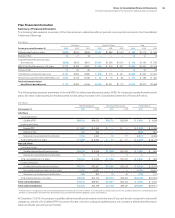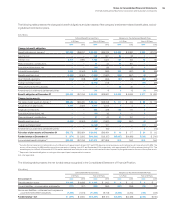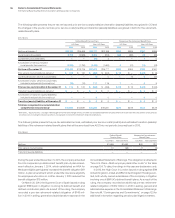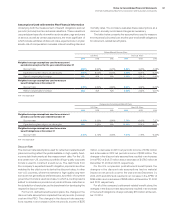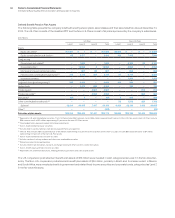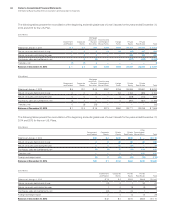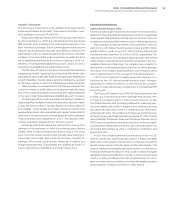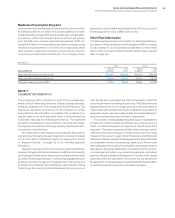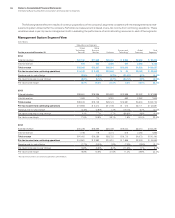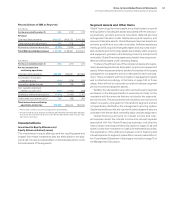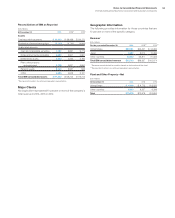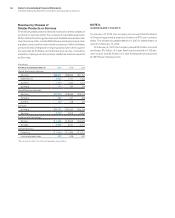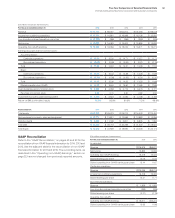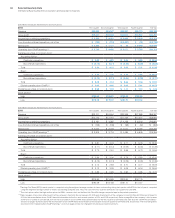IBM 2014 Annual Report Download - page 144
Download and view the complete annual report
Please find page 144 of the 2014 IBM annual report below. You can navigate through the pages in the report by either clicking on the pages listed below, or by using the keyword search tool below to find specific information within the annual report.Notes to Consolidated Financial Statements
International Business Machines Corporation and Subsidiary Companies
143
Valuation Techniques
The following is a description of the valuation techniques used to
measure plan assets at fair value. There were no changes in valu-
ation techniques during 2014 and 2013.
Equity securities are valued at the closing price reported on
the stock exchange on which the individual securities are traded.
IBM common stock is valued at the closing price reported on the
New York Stock Exchange. Equity commingled/mutual funds are
typically valued using the net asset value (NAV) provided by the
administrator of the fund and reviewed by the company. The NAV
is based on the value of the underlying assets owned by the fund,
minus liabilities and divided by the number of shares or units out-
standing. These assets are classified as Level1, Level2 or Level3
depending on availability of quoted market prices.
The fair value of fixed-income securities is typically estimated
using pricing models, quoted prices of securities with similar char-
acteristics or discounted cash flows and are generally classified as
Level2. If available, they are valued using the closing price reported
on the major market on which the individual securities are traded.
Cash includes money market accounts that are valued at their
cost plus interest on a daily basis, which approximates fair value.
Short-term investments represent securities with original maturities
of one year or less. These assets are classified as Level1 or Level2.
Private equity and private real estate partnership valuations
require significant judgment due to the absence of quoted market
prices, the inherent lack of liquidity and the long-term nature of
such assets. These assets are initially valued at cost and are
reviewed periodically utilizing available and relevant market data to
determine if the carrying value of these assets should be adjusted.
These investments are classified as Level3. The valuation meth-
odology is applied consistently from period to period.
Exchange traded derivatives are valued at the closing price
reported on the exchange on which the individual securities are
traded, while forward contracts are valued using a mid-close
price. Over-the-counter derivatives are typically valued using pric-
ing models. The models require a variety of inputs, including, for
example, yield curves, credit curves, measures of volatility and
foreign exchange rates. These assets are classified as Level1 or
Level2 depending on availability of quoted market prices.
Expected Contributions
Defined Benefit Pension Plans
It is the company’s general practice to fund amounts for pensions
sufficient to meet the minimum requirements set forth in applicable
employee benefits laws and local tax laws. From time to time, the
company contributes additional amounts as it deems appropriate.
The company contributed $465 million and $449 million in
cash to non-U.S. defined benefit pension plans and $54 million
and $57 million in cash to non-U.S. multi-employer plans during
the years ended December 31, 2014 and 2013, respectively. The
cash contributions to multi-employer plans represent the annual
cost included in net periodic (income)/cost recognized in the Con-
solidated Statement of Earnings. The company has no liability for
participants in multi-employer plans other than its own employees.
As a result, the company’s participation in multi-employer plans
has no material impact on the company’s financial statements.
In 2015, the company is not legally required to make any con-
tributions to the U.S. defined benefit pension plans. However,
depending on market conditions, or other factors, the company
may elect to make discretionary contributions to the Qualified PPP
during the year.
The Pension Protection Act of 2006 (the Act), enacted into law
in 2006, is a comprehensive reform package that, among other
provisions, increases pension funding requirements for certain
U.S. defined benefit plans, provides guidelines for measuring pen-
sion plan assets and pension obligations for funding purposes
and raises tax deduction limits for contributions to retirement-
related benefit plans. The additional funding requirements by the
Act apply to plan years beginning after December 31, 2007. The Act
was updated by the Worker, Retiree and Employer Recovery Act of
2008, which revised the funding requirements in the Act by clarify-
ing that pension plans may smooth the value of pension plans over
24 months. At December 31, 2014, no mandatory contribution was
required for 2015.
In 2015, the company estimates contributions to its non-U.S.
defined benefit and multi-employer plans to be approximately
$600 million, the largest of which will be contributed to defined
benefit pension plans in the UK, Japan and the Netherlands. This
amount represents the legally mandated minimum contributions.
Financial market performance in 2015 could increase the legally
mandated minimum contribution in certain countries which require
monthly or daily remeasurement of the funded status. The com-
pany could also elect to contribute more than the legally mandated
amount based on market conditions or other factors.


